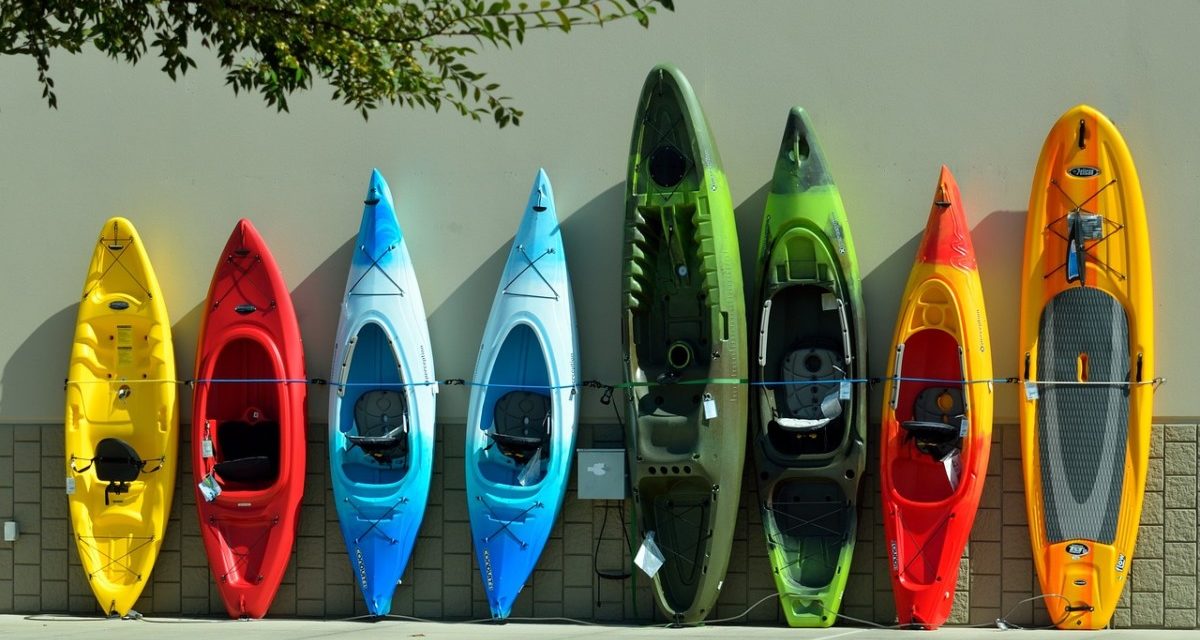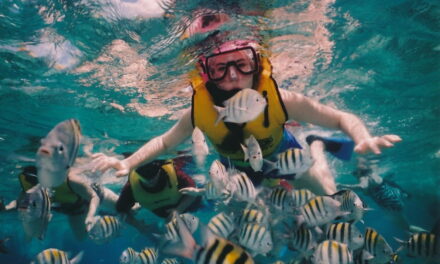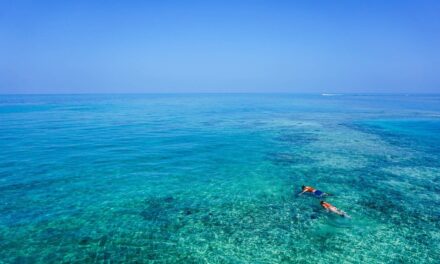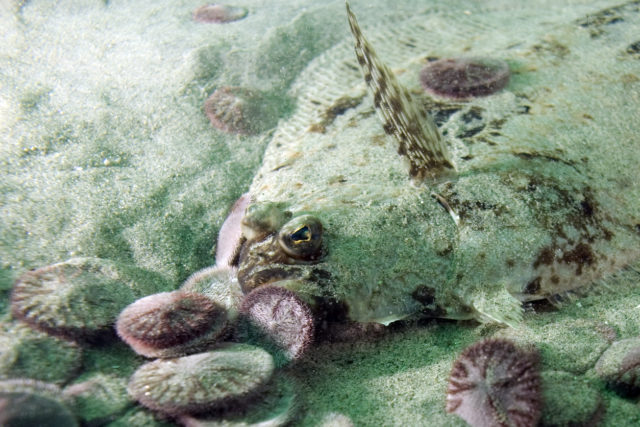Sea kayaks are the easiest, most affordable way to get to your dive spot if you’re a spear fisherman or a diver in general. Their compact size allows trouble-free launching and storage with almost no running expenses.
With the vast abundance of products on the market, you’re probably not sure where to start. No worries, we’ve got you covered. Here are some of the best sea kayaks for spearfishing on the market. Just below is a quick comparison of my top picks. Read on for more detailed information on each kayak and a buying guide at the end of the article.
Vibe Kayaks Yellowfin 130T
Vibe has been renowned for making quality kayaks, and the Yellowfin 130T is arguably their holy grail. The dimensions of this sit-on-top kayak are 156″ x 35″ x 16″ and it weighs around 80 lbs. The Yellowfin is among the very few kayaks that can withstand 3 people on board. That doesn’t mean that you can’t ride solo, the optional center paddle position can be utilized for solo paddling.
The Yellowfin comes with 2 flush mount rod holders and 4 mounting points that are designed for Scotty, Railblaza, or RAM mount rod holders. You can find plenty of room for storage like the 2 sealed hatches that come with bag inserts and the ample bungeed rear tank. The seats are super comfortable and they provide great lumbar support. Extra features include adjustable footrests for maximum comfort.
Things We Like:
- Can accommodate up to 3 people
- Plenty of storage space
- Great stability in choppy water
- Adjustable footrests
- Lifetime warranty
Things We Don’t:
- Heavy for its size range
- Expensive for its size range
Ocean Kayak Prowler 13 Angler
The Prowler is one of those kayaks that hits the nail on the head in terms of achieving a good balance of speed and maneuverability. The dimensions of this kayak are 13.4″ x 28″ x 20″ and it comes at 56 lbs of weight. This sit-on-top kayak is designed to excel in both calm water and rough seas, which makes it the perfect choice for virtually all conditions, from lakes and rivers to bays and oceans.
This yak has a large click seal front hatch that offers easy access to below-deck storage space from bow to stern. There’s a very commodious rear tank that’s great for storing coolers, crates, and scuba tanks. It also includes two paddle keeps and two cup holders. The chairs are four-way-adjustable and can support all-day paddling. Thanks to the side paddle holders, anglers will find it easy to switch from paddle to rod.
Things We Like:
- Excellent speed and stability
- Plenty of storage room
- Great tracking
- Easy to transport
- Reasonably priced
Things We Don’t:
-
- Insufficient back support
- Foot wells can be troublesome
- Not good for long trips
Sun Dolphin Journey 10 SS
This lightweight kayak is mainly designed to roam in calm lakes and rivers. It’s an ideal choice for getting to excluded fishing spots. The Dolphin’s dimensions are 120″ x 30″ x 11″ and it weighs just 44 lbs, which makes it easy to carry around. If you’re not much of an ocean surger and prefer to spend your time in a quiet lake, this is the right yak for you. The tracking and paddling are so easy to the point where it feels almost effortless.
For being such a compact kayak, there is a lot of storage room, such as the large dry storage hatch, as well as internal storage that spans from the bow to the stern. The only downside of this kayak is that it’s more geared towards portability than comfort, so spending a lot of time sitting in it might not be the best idea. Additional features include a hands-free electronics console, one swivel rod holder, and two flush mount rod holders.
Things We Like:
- Compact lightweight design
- Enough storage space
- Adjustable foot braces
- Hands-free electronics console
Things We Don’t:
- Not a fast vessel
- Low load capacity
- The seat bottom isn’t padded
Old Town Vapor 12 Angler
This is a kayak that refuses to compromise on any of any of the primary attributes that make for a good watercraft. The Vapor’s dimensions are 144″ x 28.5″ x 19.5″ and it weighs around 56 lbs. The abundance of interior space and the boat control options are some of the reasons why this kayak is a very tough competitor. Not to mention that it’s one of the most affordable kayaks on this list and on the market.
This kayak is just loaded with features, such as the Comfort Flex adjustable padded seat, thigh pads, and the adjustable foot braces. It also comes with molded carry handles, drain plug, skid plate, and a stern day-well for storage. The angler features are two flush-mounted rod holders, a deck bungee, and an anchor with a trolley system. The cockpit includes a molded-in tray, a cup holder, and a paddle park.
Things We Like:
- Reasonably priced kayak
- Easily accessed nice sized cockpit
- Very good tracking
- Anchor with a trolley system
- The seat is easily adjustable
Things We Don’t:
- Longer turning time due to length
- The day-well is not completely sealed
Ocean Kayak 12-Feet Malibu
The 12-Feet Malibu might be the most well-known sit-on-top kayak on this list. This kayak can fit up 2 adults or 2 adults and 1 child, with the option to use it for solo trips as well. It has 144″ x 34″ x 20″ and weighs about 57 lbs. Thanks to the overlapping foot wells, any paddler should be comfortable using this watercraft regardless of size.
The design of the hull and deck design allows for easy stacking of multiple hulls for on-dock storage. Some of the features that come with this yak are the Comfort Plus seats, three seat wells molded within the vessel, a skid plate that increases durability, and the bungee gear straps allow you to pack all of your necessary gear. Also, the presence of carrying handles at the bow and the stern allows for an easy portage and transportation process.
Things We Like:
- Can accommodate 3 people
- Various paddling positions
- Overlapping foot wells
- Carry handles for easy transportation
Things We Don’t:
- Small width
- Limited color choice
The Buying Guide
There are quite a few factors that you need to pay close attention to before going out to buy a fishing kayak. These might seem small or unimportant but their effects become apparent on longer trips.
Weight
While the weight of your yak might not have a huge effect on its performance, it plays a major role in its transportation. Unless you have your yak anchored in the water, you’ll have to transfer it from home and onto the car, then transfer it from the car and into the water. Spare yourself this hassle by buying a lightweight kayak. The majority of kayaks typically come at a deadweight of 50 to 70 lbs. Also, bear in mind that the more accessories you have, the more they add to the weight.
Width
It’s crucial to understand how the width of your yak affects its overall performance, especially if you’re a beginner. Wider kayaks provide a more stable ride than thinner ones. Also, they tend to offer a lot more storage space as well. On the other hand, thinner yaks tend to move a lot faster and they offer better maneuverability due to less drag force. Since speed is something that a fisherman can do without, a yak with a greater width is always going to be the ideal choice for a beginner or a non-beginner fisherman.
Stability
There are two types of stability when it comes to a watercraft, primary and secondary stability. Primary stability is basically how stable a vessel is when it’s sitting flat on the water. Secondary stability refers to a vessel’s ability to remain stable when tipped on its side, which is a very important aspect in a kayak. Looking at the shape of the hull can help determine its secondary stability capabilities. Not only do hull shapes affect the overall stability of kayak, but they also its speed. Pontoon hulls tend to offer the best balance between primary and secondary stability.
Speed
Speed is an important factor to consider if you plan on taking your yak on long distance trips. You surely don’t want to be in the ocean as darkness begins to fall, so you need to be sure that your kayak will be fast enough on your way back to the shore. Also, a fast kayak will grant you more freedom in exploring fishing spots that are far into the sea without having to worry too much about getting back on time.
Storage
Storage is especially important in kayaks as you will likely be packing a lot of fishing gear along with you on your trip. An ideal fishing kayak should have an internal storage space that spans from the bow to the stern. You also need to make sure that your yak offers dry storage space. Additionally, bungee cords are great for attaching additional gear.
Comfort
A comfortable and padded seat is one of the most important aspects of a fishing kayak. Having a seat that you can easily adjust its position might not be significant, but sitting in one position can cause you a great deal of discomfort, so make sure that your seats are adjustable into more of a reclined position that will help you sit for long periods of time without feeling uncomfortable. It’s also worth mentioning that you need to make sure that your kayak even comes with a seat since some of them don’t.
Design
Most fishing kayaks tend to be on the bigger side which allows for a variety of storage options such as bungee systems and dry hatches. Further, if you’re opting for sit-inside kayaks you’ll find that they offer knee braces to support your legs. A quality fishing kayak should have adjustable areas that will allow your legs to move and extend without restrictions.
Materials
Fishing kayaks are usually made out polyethylene, which is a type of durable plastic that can withstand concavities or grooves caused by the sea. This isn’t a good material to be left under the sun for too long because it could be warped. Another material that’s often used is fiberglass. While it’s not as resistant to damage as plastic, it’s lighter and easier to repair. A very few high-end kayaks use carbon or kevlar as a building material as they’re ultralight and extremely durable. However, these materials tend to come at a steep price.
Sit On Top Kayaks
A Sit-On-Top kayak is designed to handle harsh surf conditions and for leisure use. Typically, the cockpit is on top where the paddler sits. Below the cockpit, you’ll find scupper holes that help drain water that might get into the cockpit. Many SOT fishing kayaks come with extra fishing accessories, which makes them the go-to choice for a lot of fishermen since it helps them save money and spare them the hours of installing these accessories.
This type of kayaks is designed to stay in an upright state even in extreme conditions. SOT kayaks are also self-bailing, which means that you won’t need to worry about pumping water. Also, they offer a lot of storage room for your gear. Most models have a spot located behind the seat to for your cooler or fish bag. Further, they have watertight hatches for dry storage. Entering and exiting a SOT kayak is as simple as hopping on and off it.
On the other hand, you’re almost guaranteed to get wet if a wave crashes over the yak or if it rains since you’re out in the open. Also, the amount of stability that a SOT kayak provides comes at the expense of their weight, as they are heavier than SI kayaks and more difficult to move around. Moreover, being on top of a SOT gives the wind more mass to hit. That’s why a lot of fishermen install an anchor and a rudder system which helps reduce the effect of wind on you and the kayak.
Sit Inside Kayaks
Sit-Inside kayaks have more of a traditional style to them and are the most familiar type to fishermen. A sit-inside kayak, as you might have figured, has a hull that allows you to sit inside of it and have your legs underneath the front deck. Most fishermen are now embracing the use of SOT kayaks which have dropped down the popularity of SI kayaks. However, this type is still used in certain conditions such as cold weather and keeping your body insulated from the water.
Fishing in the winter on a SOT kayak can be quite the struggle. That’s why SI kayaks are more likely to be used in cold conditions because they keep your lower body insulated from the air outside. This type also offers better protection against the wind since half your body mass is sitting low inside the cockpit. Additionally, SI yaks are a lot lighter than their SOT counterparts and can even be carried around.
The downside of sit-inside kayaks is that there are no draining holes so water can get trapped inside. You’ll have to manually pump the water out or use a sponge. Another disadvantage is that this type lacks in terms of storage space, and even the little space that they have can be quite hard to access. Storage room isn’t the only thing that’s hard to access on an SI kayak, the kayak itself can be hard to get in and out of. Also, SI kayaks might not the best option to use in warmer weather conditions as they easily get hot.
Final Words
All of the products mentioned in this article are able to do the job with almost equal efficiency. However, picking the right one for you depends on analyzing the slight variations in features and specs between them and figuring out which ones you do with and which you can do without. Hopefully, you’ve found our information helpful and are now ready to make a smart purchasing decision.






